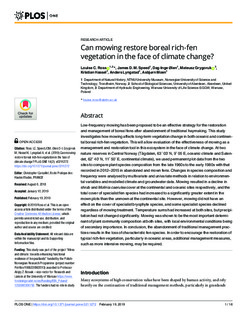| dc.contributor.author | Ross, Louise C. | |
| dc.contributor.author | Speed, James David Mervyn | |
| dc.contributor.author | Øien, Dag-Inge | |
| dc.contributor.author | Grygoruk, Mateusz | |
| dc.contributor.author | Hassel, Kristian | |
| dc.contributor.author | Lyngstad, Anders | |
| dc.contributor.author | Moen, Asbjørn | |
| dc.date.accessioned | 2019-03-08T10:19:04Z | |
| dc.date.available | 2019-03-08T10:19:04Z | |
| dc.date.created | 2019-03-07T08:42:45Z | |
| dc.date.issued | 2019 | |
| dc.identifier.citation | PLoS ONE. 2019, 14 (2), . | nb_NO |
| dc.identifier.issn | 1932-6203 | |
| dc.identifier.uri | http://hdl.handle.net/11250/2589325 | |
| dc.description.abstract | Low-frequency mowing has been proposed to be an effective strategy for the restoration and management of boreal fens after abandonment of traditional haymaking. This study investigates how mowing affects long-term vegetation change in both oceanic and continental boreal rich-fen vegetation. This will allow evaluation of the effectiveness of mowing as a management and restoration tool in this ecosystem in the face of climate change. At two nature reserves in Central Norway (Tågdalen, 63° 03’ N, 9° 05 E, oceanic climate and Sølendet, 62° 40’ N, 11° 50’ E, continental climate), we used permanent plot data from the two sites to compare plant species composition from the late 1960s to the early 1980s with that recorded in 2012–2015 in abandoned and mown fens. Changes in species composition and frequency were analysed by multivariate and univariate methods in relation to environmental variables and modelled climate and groundwater data. Mowing resulted in a decline in shrub and Molinia caerulea cover at the continental and oceanic sites respectively, and the total cover of specialist fen species had increased to a significantly greater extent in the mown plots than the unmown at the continental site. However, mowing did not have an effect on the cover of specialist bryophyte species, and some specialist species declined regardless of mowing treatment. Temperature sums had increased at both sites, but precipitation had not changed significantly. Mowing was shown to be the most important determinant of plant community composition at both sites, with local environmental conditions being of secondary importance. In conclusion, the abandonment of traditional management practices results in the loss of characteristic fen species. In order to encourage the restoration of typical rich-fen vegetation, particularly in oceanic areas, additional management measures, such as more intensive mowing, may be required. | nb_NO |
| dc.language.iso | eng | nb_NO |
| dc.publisher | Public Library of Science (PLOS) | nb_NO |
| dc.rights | Navngivelse 4.0 Internasjonal | * |
| dc.rights.uri | http://creativecommons.org/licenses/by/4.0/deed.no | * |
| dc.title | Can mowing restore boreal rich-fen vegetation in the face of climate change? | nb_NO |
| dc.type | Journal article | nb_NO |
| dc.type | Peer reviewed | nb_NO |
| dc.description.version | publishedVersion | nb_NO |
| dc.source.pagenumber | 16 | nb_NO |
| dc.source.volume | 14 | nb_NO |
| dc.source.journal | PLoS ONE | nb_NO |
| dc.source.issue | 2 | nb_NO |
| dc.identifier.doi | 10.1371/journal.pone.0211272 | |
| dc.identifier.cristin | 1682775 | |
| dc.description.localcode | Copyright: © 2019 Ross et al. This is an open access article distributed under the terms of the Creative Commons Attribution License, which permits unrestricted use, distribution, and reproduction in any medium, provided the original author and source are credited. | nb_NO |
| cristin.unitcode | 194,31,10,0 | |
| cristin.unitname | Institutt for naturhistorie | |
| cristin.ispublished | true | |
| cristin.fulltext | original | |
| cristin.qualitycode | 1 | |

